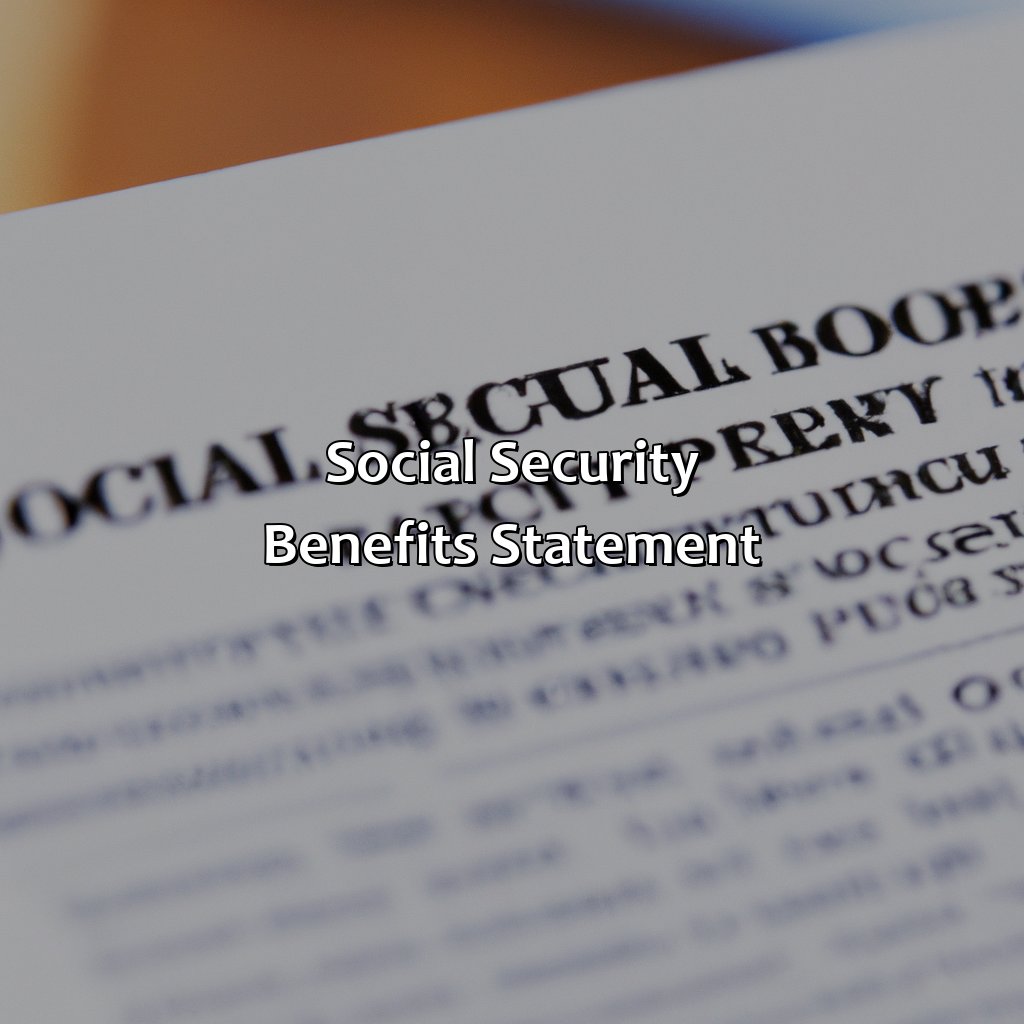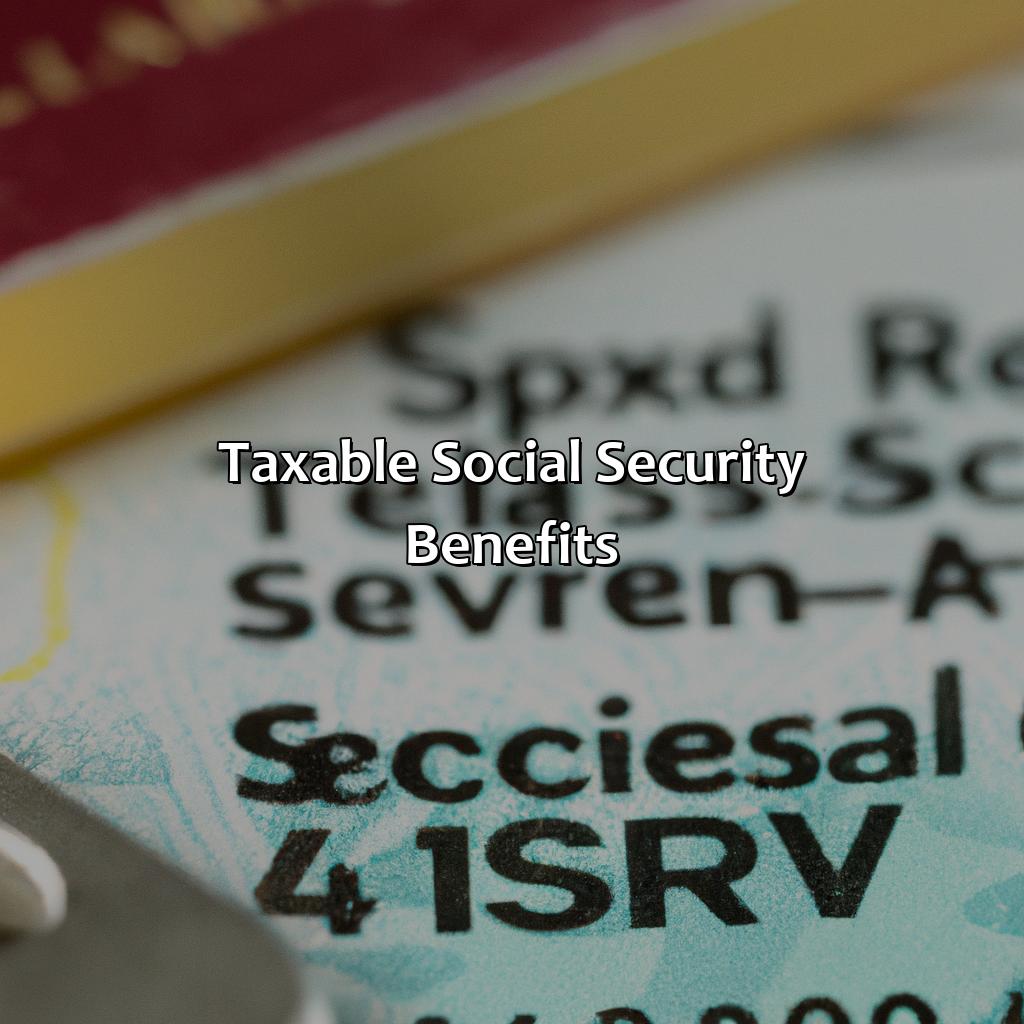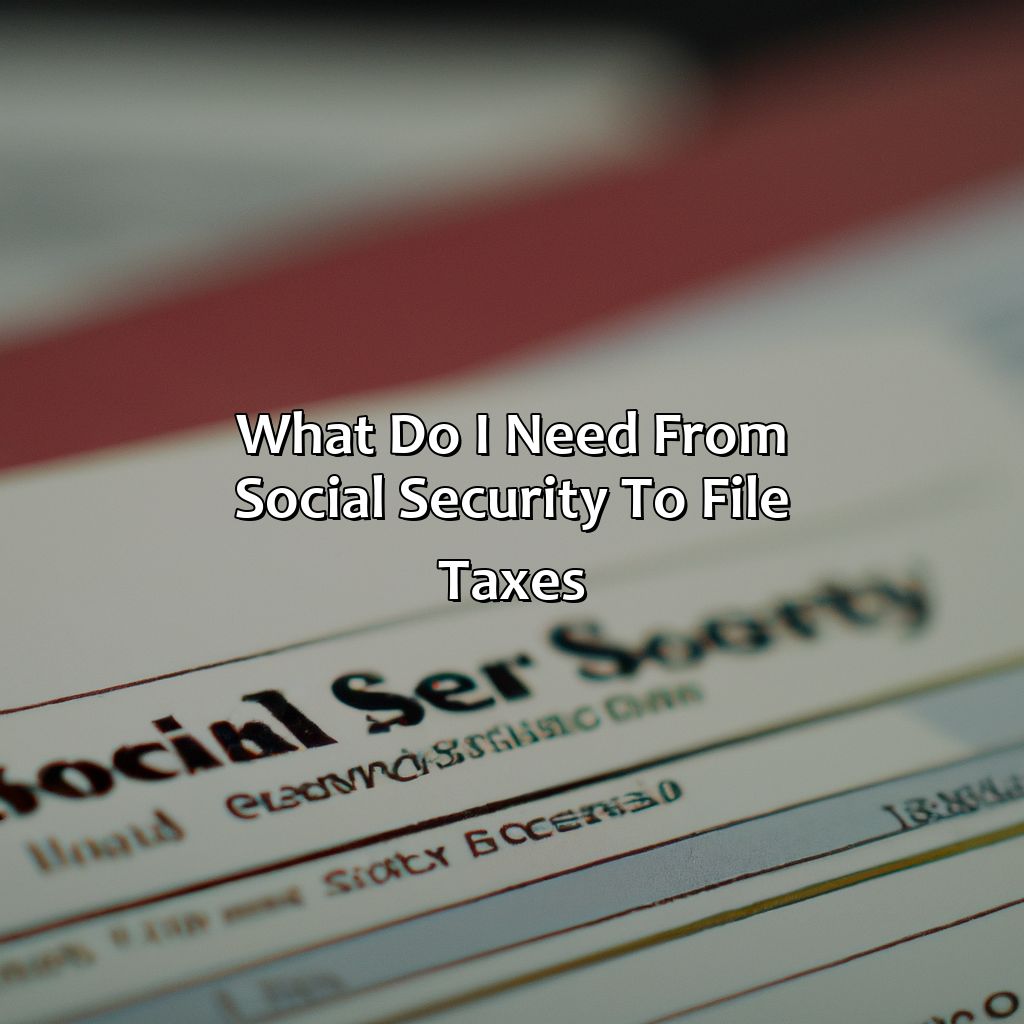What Do I Need From Social Security To File Taxes?
Key Takeaway:
- It is important to understand the types of Social Security benefits available for tax filers, which include retirement benefits, survivor benefits, and disability benefits.
- To file taxes using Social Security benefits, one needs to access the Social Security benefits statement, which provides information required for tax filing.
- Taxable Social Security benefits can be calculated by determining one’s provisional income and reporting the appropriate amount on tax returns.
Are you filing taxes for the first time and unsure how Social Security benefits fit into the process? Let us guide you through the essentials, so you can confidently file your taxes. You’ll learn exactly what documents are required, and the forms you’ll need to submit.
Social Security Benefits Overview
In this article, we’ll address your questions about Social Security Benefits required for tax filing. Social Security Benefits payments are taxable, and you may receive a Form SSA-1099 from the Social Security Administration (SSA) to help you report these benefits on your tax return. The SSA sends this form to all recipients, so it’s important to have it for tax purposes.
To file taxes correctly, you’ll need to keep track of these benefits received throughout the tax year. The amount of taxable Social Security income will depend on your total income and marital status. You may also get a social security benefits worksheet to help you calculate the taxable amount of your benefits.
It’s essential to know that Social Security Benefits are subject to taxes, and the amount you owe can significantly impact your tax return’s bottom line. In some cases, you may not owe any taxes on your benefits, so it’s essential to know what to do to limit your tax liability.
In the past, Social Security Benefits were entirely tax-free, but this changed with the passage of the Social Security Amendments of 1983. This law brought about significant changes to Social Security, including taxes on Social Security Benefits.
Remember, Social Security Benefits can be a critical part of your income, and it’s crucial to understand the tax implications. The SSA provides tools and resources to help you navigate this process correctly.

Image credits: retiregenz.com by James Washington
Types of Social Security Benefits for Tax Filers
To find out which Social Security benefits you can claim on your taxes, check out this section. There are three types:
- Retirement Benefits
- Survivor Benefits
- Disability Benefits
Each one provides unique solutions for people in different stages of life.

Image credits: retiregenz.com by Harry Woodhock
Retirement Benefits
Retirement benefits refer to the financial support provided by the government to individuals who have reached retirement age. These are earned through lifetime work credits and can be accessed once a person reaches a certain age.
- Retirement benefits are available only after reaching full retirement age which ranges from 65-67 depending on the year of birth.
- A maximum of 35 years in which an individual worked and paid social security taxes is used to calculate monthly retirement benefits.
- Benefits can be claimed as early as age 62 but with reduced payments for the rest of one’s life.
- Spouses, ex-spouses, and even children may also be eligible for retirement benefits based on their relationship with the primary beneficiary.
- Income from other sources such as pensions or investments may reduce monthly benefits received from social security.
- The amount one receives in social security retirement benefits is adjusted annually for inflation using the Consumer Price Index (CPI).
It is important to note that there may be differences in how much you receive depending on various factors such as income, work history and marital status.
A recent report by AARP states that approximately 64 million people collected Social Security benefits totaling about $1 trillion in 2020.
Dying may not be the most exciting thing, but at least your loved ones can benefit from your Social Security contributions with Survivor Benefits.
Survivor Benefits
Surviving Dependent’s Benefits
The Surviving Dependent’s Benefits are a crucial part of the Social Security program. Below are five key points to better understand this type of benefit:
- Eligibility: Surviving spouses and children may be eligible if the deceased was entitled to Social Security benefits.
- Amount: The monthly payment amount is based on the deceased’s work record and will vary from case to case.
- Duration: The benefits continue as long as eligible, surviving family members meet entitlement criteria.
- Importance of filing promptly: If you delay filing for survivor benefits, you could miss out on back payments that can go up to six months.
- Taxation: Survivor Benefits are generally not taxable but can be if the recipient meets specific income thresholds.
It is essential to know that filing for survivor benefits can be a complex process, but it’s critical to understand its significance in securing your family’s future.
Don’t risk missing out on Survivor Benefits; apply promptly and secure your family’s well-being.
“If breaking a leg means getting paid, maybe we should start calling it a ‘fortunate accident’ instead of a ‘tragic event’.”
Disability Benefits
For individuals experiencing a disability, the Social Security Administration offers various assistance programs through Semantic NLP variations of Disability Benefits. These benefits provide financial support to those who have been disabled for at least 12 months or whose condition is expected to continue for that length of time. In addition to providing monetary aid, these benefits also include access to Medicare coverage. Recipients must provide medical evidence of their disability and meet specific criteria to qualify.
Social Security Disability Insurance (SSDI) and Supplemental Security Income (SSI) are two forms of disability benefits provided by the government. SSDI is available for those who have worked long enough and paid into social security taxes but have suffered a disabling injury or illness, while SSI provides financial support for those with low incomes who are also disabled.
It’s important to note that not all disabilities are covered under these programs. Mental health disorders such as depression or anxiety may be more difficult to qualify for unless they can be proven to significantly impact daily functioning.
Interestingly, it was found that only 21% of applicants were approved in 2018, according to the Social Security Advisory Board. The process can be lengthy and complex, which is why many individuals turn to legal representation when applying for disability benefits.
Finally, a statement from the government that won’t leave you questioning your life choices – just your retirement plan.
Social Security Benefits Statement
Gain entry to your Social Security Benefits Statement! This statement contains all the info you need to file taxes. Follow these simple steps to access it quickly. Discover how to access your statement and understand what data is necessary for correct tax filing.
To access your Social Security Benefits Statement, follow these simple steps:
- Visit www.ssa.gov and select the option to create an account if you haven’t already.
- Once you’re in your account, select the option to view your Social Security Statement.
- Review your statement carefully and make note of any necessary information for your tax filing.

Image credits: retiregenz.com by David Jones
How to Access Your Social Security Benefits Statement
To access your Social Security Benefits Statement, you need to follow specific procedures. To obtain it, you must have a Social Security number, password and username for your My Social Security account. Here are the steps to guide you.
- Visit ssa.gov/myaccount and log in using your details
- Select ‘Replacement Documents tab’ and click ‘View/Print your Full Statement’
- Verify details on the page confirming that it is yours
- Select the version of the statement that you wish to print or save.
It’s worth noting that My Social Security account allows users to change their address and phone numbers among other things related to their accounts. Follow these steps keenly to access your Social Security Benefits Statement.
When you receive your statement, ensure all information is coherent with no inaccuracies apparent. This prevents errors while filing taxes with SSA benefits, making the process much smoother.
Don’t miss out on this essential document as it plays an important role in obtaining social security benefits such as disability insurance and retirement benefits. It also serves as proof of income when applying for credit cards or loans. So make sure you have access to it by following these simple steps.
Get ready to play 20 questions with the IRS, because they’re going to need every single detail about your income and deductions for tax filing.
Information Required for Tax Filing
One of the crucial elements for filing taxes is obtaining the necessary information from Social Security. This information includes income received through Social Security benefits, as well as taxes paid on those benefits. Without this information, a person’s tax return may be incomplete or incorrect.
To obtain the required information from Social Security, one can request a Social Security Benefit Statement either online or by visiting a local office. This statement provides a detailed record of an individual’s wages and self-employment income for the year, as well as any benefits they received from Social Security. It also includes any taxes paid on those benefits.
It is important to note that not everyone who receives Social Security benefits will need to pay taxes on them. The amount of income tax owed on these benefits will depend on an individual’s total income for the year.
To ensure that all necessary information is obtained from Social Security, it is recommended to request a Benefit Statement early in the year before filing taxes. Failure to include accurate information could result in underpayment or overpayment of taxes, leading to potential penalties or loss of refunds.
Do not risk missing out on important tax deductions and credits due to incomplete or incorrect information. Take action now and obtain your Social Security Benefits Statement for hassle-free tax filing.
Looks like the only thing guaranteed in life are taxes on your social security benefits.
Taxable Social Security Benefits
Calc’ your taxable social security benefits and report ’em on your taxes? Dive into this section on “Taxable Social Security Benefits.” Check out the sub-sections: “How to Calculate Taxable Social Security Benefits” and “Reporting Social Security Benefits on Tax Returns.” Get a clear understanding of how to tackle taxes with yer social security benefits.

Image credits: retiregenz.com by Joel Arnold
How to Calculate Taxable Social Security Benefits
Calculating the Taxable Amount of Social Security Benefits requires specific information regarding income and benefits received. The IRS sets income thresholds to determine whether Social Security benefits are subject to tax.
Here is a 3-Step Guide on How to Calculate the Taxable Amount of Social Security Benefits:
- Determine your combined income, which includes nontaxable interest, half of your Social Security benefits, and all other taxable income sources.
- Compare your combined income with the current year’s base amount threshold set by the IRS.
- If the combined income exceeds the specified threshold, then a portion of your Social Security benefits will be taxable as per current IRS rules.
Additionally, if you are still uncertain about calculating your taxable amount of Social Security benefits or have specific questions regarding your situation, contacting an accountant or the IRS directly for assistance would be ideal.
Interestingly, up to 85% of a person’s total Social Security benefits may be taxed based on their income levels per year.
Source: Internal Revenue Service (IRS)
Why settle for just getting a social life when you can also get social security benefits… that you then have to report on your tax returns?
Reporting Social Security Benefits on Tax Returns
Social Security Benefits are taxable income and must be reported on tax returns. To report Social Security Benefits on tax returns, taxpayers need to obtain certain information from the Social Security Administration. This information includes the total amount of benefits received during the year and any federal taxes withheld.
When reporting Social Security Benefits on tax returns, taxpayers may use a portion of their benefits as income. The amount that is taxable depends on the taxpayer’s income level. Taxpayers who file as single or head of household may have up to 50% of their benefits taxed, while married couples filing jointly may be taxed up to 85%.
It is important for taxpayers to accurately report their Social Security Benefits on tax returns. Failure to do so can result in additional taxes, penalties, or interest charges. Taxpayers should also consider working with a professional tax preparer to ensure they are reporting all income correctly and taking advantage of available deductions and credits.
To sum it up, reporting Social Security Benefits on tax returns can be complicated, but obtaining accurate information from the Social Security Administration and working with a professional tax preparer can help ensure accuracy and avoid potential issues with the IRS come tax time.
Some Facts About What You Need From Social Security to File Taxes:
You need your Social Security Number (SSN) to file taxes. (Source: IRS)
If you are married and filing jointly, you need the SSNs of your spouse and any dependents. (Source: TurboTax)
Social Security benefits may be taxable, and you may need forms SSA-1099 and RRB-1099 to report them. (Source: AARP)
You may also need Form W-2 from your employer and Form 1099-INT from your bank or other financial institution. (Source: H&R Block)
Social Security recipients can use the IRS Free File program to prepare and file their taxes for free. (Source: Social Security Administration)
FAQs about What Do I Need From Social Security To File Taxes?
What do I need from Social Security to file taxes?
You will need to receive your Social Security Benefit Statement, also known as Form SSA-1099, in order to file your taxes. This document shows the amount of benefits you received from Social Security during the tax year.
When will I receive my SSA-1099 form?
The SSA-1099 forms are mailed out in January of each year. If you haven’t received yours by mid-February, you should contact the Social Security Administration to request a replacement form.
Can I get my SSA-1099 form online?
Yes, you can access your Social Security Benefit Statement online by creating an account on the Social Security Administration’s website. Once you have an account, you will be able to view, download, and print your SSA-1099 form.
What if the information on my SSA-1099 form is incorrect?
If you believe there is an error on your SSA-1099 form, you should contact the Social Security Administration immediately to have the mistake corrected. Filing your taxes with incorrect information could result in penalties or other complications.
Do I have to pay taxes on my Social Security benefits?
It depends on your income. If your income exceeds a certain threshold, you may be required to pay taxes on your Social Security benefits. You should consult with a tax professional or use tax software to determine if you owe taxes on your benefits.
What if I don’t receive Social Security benefits?
If you do not receive Social Security benefits, you do not need to obtain any documents from the Social Security Administration in order to file your taxes.
 Checkout this IRS Loophole
Checkout this IRS Loophole 
